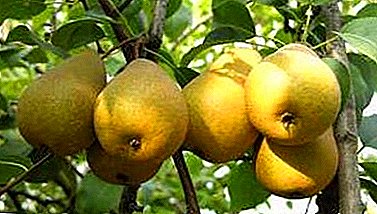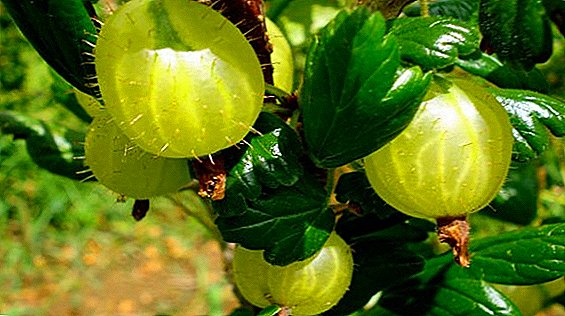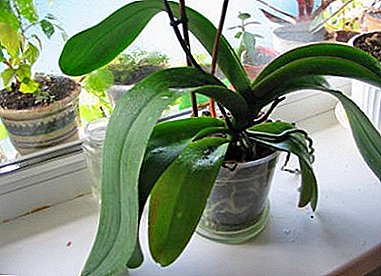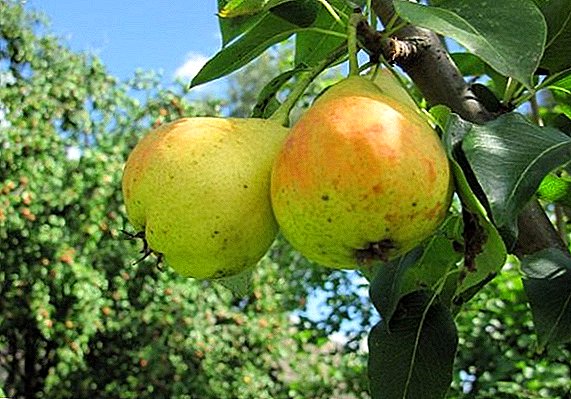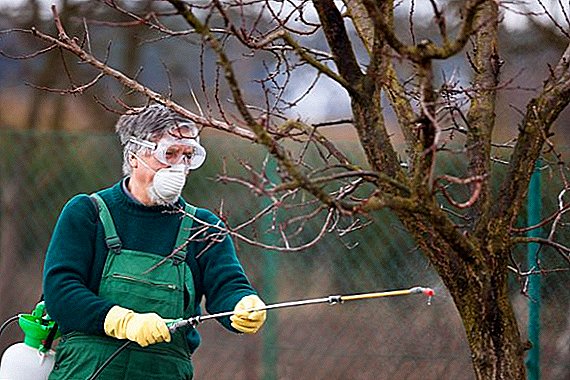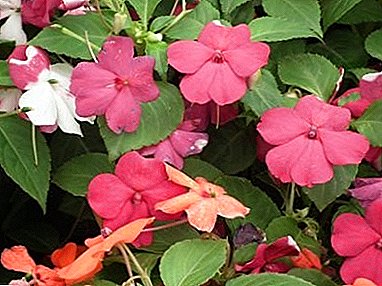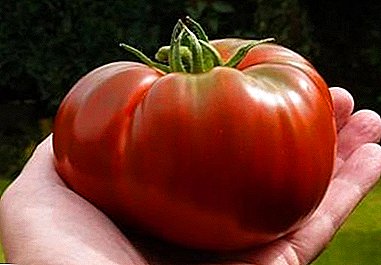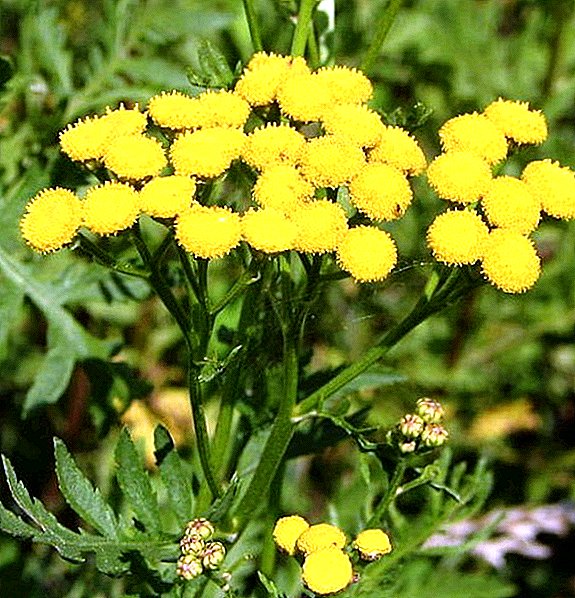 Medicinal properties of tansy are recognized not only by folk, but also by official medicine. Moreover, perennial is included in the pharmacopoeia of a number of highly developed countries. And if herbalists strive to ensure that the stocks of dry raw materials of this plant are never taken out of the house, then ordinary citizens, who do not have information about its healing properties, can not pay attention to inconspicuous shrubs. What are the features tansy, whether the grass is shown to everyone, and how to treat it - we will tell about this later.
Medicinal properties of tansy are recognized not only by folk, but also by official medicine. Moreover, perennial is included in the pharmacopoeia of a number of highly developed countries. And if herbalists strive to ensure that the stocks of dry raw materials of this plant are never taken out of the house, then ordinary citizens, who do not have information about its healing properties, can not pay attention to inconspicuous shrubs. What are the features tansy, whether the grass is shown to everyone, and how to treat it - we will tell about this later.
Tansy: botanical characteristic
To find tansy in temperate climates - not a problem. Grass is found everywhere: on the outskirts of roads, forest edges, marshy floodplains, banks of reservoirs, in mountainous and steppe areas.  This is a very common herbaceous perennial, which botanists combine into a separate genus and are credited to the Aster family.
This is a very common herbaceous perennial, which botanists combine into a separate genus and are credited to the Aster family.
In the world, scientists distinguish about 170 species of this plant. Half of them are widely known to residents of European countries.
Did you know? Linguists connect the origin of the Latin name tansy (tanacetum) with the Greek words "tanaos" and "aceomai", which in translation means "long life".
Some instances of tansy are found only in North African or Asian states. A third prefers to develop in Russia.
Externally, the grass is a perennial shrub with lignified roots, tall stems, feathery leaves and small inflorescences.
If you look closely, you will surely remember that you have met such a plant more than once. In favorable conditions, it can reach a meter height. In old sprouts, the radical part is also woody. To the top shoots slightly pubescent and branched.  Rough foliage is characterized by a dark green shade, and a complex structure that is very similar to rowan leaf plates. It is because of this feature that tansy is commonly referred to as a field or wild mountain ash.
Rough foliage is characterized by a dark green shade, and a complex structure that is very similar to rowan leaf plates. It is because of this feature that tansy is commonly referred to as a field or wild mountain ash.
The plant blooms at the beginning of summer, keeping its small bright yellow inflorescences until September. Plain flower pompoms of tansy are much like buttons, which explains another common name of the herb.
Important! It is categorically contraindicated to prepare decoctions and tinctures of tansy in aluminum tanks. The fact is that the plant components of the plant, even for a short time in the pot, react with the material. As a result, the formation of harmful compounds resistant to health.
In the autumn, round stems with ribbed edges ripen on tansy stems. To the best of growth, they burst, thereby contributing to the emergence of self-seeding.
Chemical composition
In many scientific sources, tansy is characterized as a medicinal, ether-oil, food, honey-bearing and at the same time poisonous herb.
Such an explosive mixture of healthy and hazardous characteristics is due to its rich chemical composition. Among its nutrients the lion's share is occupied by:
- essential oil, the amount of which depends on the time of gathering plant materials (most of it is found in the culture during the flowering period - from 1.5 to 2%);
- ascorbic acid (vitamin C);
- alkaloids (from 0.04 to 0.5%);
- polysaccharides;
- glycosides;
- tanacetic organic acid;
- galactic acid;
- tannins (0.1%);
- tanacetin (bitter substance);
- flavonoids (luteolin, quercetin, cosmosiin, isorhamnetin, tilianthin);
- phenol carboxylic acids (caffeic, chlorogenic);
- carotenoids;
- routine
 Many herbalists recommend using dry or fresh inflorescences as well as tansy leaves for treatment. This is due to the high concentration of essential oil. It is a liquid of a saturated yellow or greenish color.
Many herbalists recommend using dry or fresh inflorescences as well as tansy leaves for treatment. This is due to the high concentration of essential oil. It is a liquid of a saturated yellow or greenish color.Did you know? The ancient Egyptians knew that tansy was an excellent insecticide. This is evidenced by the fact that various powders, aerosols and extracts for embalming the departed were made from the grass.
The therapeutic feature of this component of the plant is the combination of pinene, L-camphor, borneol, dioxylactontanacetin and thujone.
The last nutrient gives toxicity to grass. It is characteristic that the amount of this substance depends on the place of growth of the bush. You should be aware that those that grow in the shade are less toxic.
Medicinal properties of tansy
Tansy is widely used by herbalists as an antioxidant, analgesic, wound healing, tonic and anti-inflammatory agent. Used in moderate quantities, toxic substances destroy pathogenic microbes and contribute to the tightening of rotting wounds.  Moreover, the plant has a beneficial effect on the liver, gallbladder and digestive organs.
Moreover, the plant has a beneficial effect on the liver, gallbladder and digestive organs.
Important! Tansy can not tolerate bedbugs, mosquitoes and fleas. In order to get rid of these annoying insects, it is enough to put a bouquet in the room with several blossomed buds.
Despite its toxicity, the plant is useful for the following diseases:
- gastritis;
- ulcers of the gastrointestinal tract;
- digestive disorders;
- gallbladder dysfunction;
- excessive gas formation;
- bloating;
- cramps;
- helminthiasis;
- neuralgia;
- headache;
- rheumatism;
- cold;
We recommend to learn how to use in the treatment of colds: salvia, cornflower, echinacea, barberry, catnip, aloe and the well-known ginger tea.
- tuberculosis;
- fever;
- cystitis;
- polyarthritis;
- epilepsy;
- convulsions;
- migraine;
- hysteria;
- failures in the menstrual cycle;

Benefit from normalization of the menstrual cycle: pomegranate juice, drone milk, nut grass, dill, parsley, ivan tea, savory juice, burdock juice, hemlock and rhubarb.
- scabies;
- eczema;
- dandruff;
- jaundice;
- cholecystitis;
- hepatitis;
- angiocholitis;
- flu;
- bronchial asthma;
- dysentery;
- constipation;
- reduced acidity of the stomach;
- gout;
- furunculosis;
- pyelonephritis;
- urolithiasis disease;
- enterocolitis;
- hypotension (low blood pressure);
- nervous disorders.
Medical applications
Tansy extract is popular in the cosmetic industry because it is a versatile ingredient for many body, face and hair care products.  The plant also acts as an active substance in a number of choleretic, renal and gastric preparations.
The plant also acts as an active substance in a number of choleretic, renal and gastric preparations.
Important! Even a small part of this medicinal herb can provoke severe poisoning in livestock. If a cow eats a couple of leaves of tansy, its milk will acquire an unpleasant peculiar smell and bitter taste.
In the global pharmaceutical market today, Belgian, Finnish and Portuguese anthelmintic medicines based on common tansy are in great demand.
In addition, in any pharmacy there are tools that are used to treat intestines, liver, asthma, rheumatism. There are also special gastric fees, the main component of which is this plant. The secret to the effectiveness of tansy is due to the complex effect of the constituent substances.  Once in the body, they increase the secretion of the gastrointestinal tract, increase intestinal motility, strengthen the immune system and optimize the activity of the cardiovascular system. As a result of blood flow, the internal organs improve their work.
Once in the body, they increase the secretion of the gastrointestinal tract, increase intestinal motility, strengthen the immune system and optimize the activity of the cardiovascular system. As a result of blood flow, the internal organs improve their work.
Also a positive effect on the state of the cardiovascular system have: hellebore, chervil, radish, cumin, zyuznik and honeysuckle.
People who suffer from hypotonic disease, frequent headaches and nervous excitability, doctors recommend drinking from the infused flowers of the plant.
After a seven-day course, normalization of blood pressure and the amplitude of heart contractions is noted, and arrhythmia is also eliminated.
Note that traditional medicine advises a tansy potion in the same cases as the official one, but similar herbal medicine requires special accuracy in dosage. In women in an interesting position, exceeding the recommended rate can cause severe bleeding and termination of pregnancy.
In the ancient collections of recipes you can find tips on the preparation of special decoctions, which our ancestors used as a deadly poison for unwanted fetus.
Today, these abortive techniques there are many alternatives that are completely harmless to the health of the potential mother. 
Possible harm and contraindications
Despite the extensive list of diseases that can cure the flowers and leaves of the plant, do not forget about its toxicity. Based on this, expectant mothers, women in the period of lactation and children who have not reached the age of twelve, can take any drug and medicines from tansy that are categorically contraindicated.
Also, you can not use the grass to people with individual intolerance components of the plant components.
Did you know? Russian merchants used tansy powder to preserve meat: the product was sprinkled with powder and wrapped in cloth — as such it could be safely transported over long distances.
The herb is a strong allergen. With particular caution it should be treated to the cores and persons who are hypersensitive to Asteraceae group asteraceae (chrysanthemums, daisies, ragweed).
In any case, do not interfere with the preliminary medical examination and consultation of a specialist. You can not independently diagnose the disease and prescribe treatment.
Moreover, long-term intake of vegetable potion can provoke serious complications, poisoning and even death. In medical practice, there were cases when people were saying goodbye to life because of 10 drops of extracted oil.  Anxiety symptoms that indicate an overdose of herbal medicines are:
Anxiety symptoms that indicate an overdose of herbal medicines are:
- nausea and vomiting;
- sharp abdominal pain, cramps;
- diarrhea;
- convulsions.
In such situations, you must immediately flush the stomach and take the adsorbent. If after such actions the symptoms are not eliminated, consult a doctor.
Harvesting and storage of raw materials
Given the toxicity of the plant, many are very careful when harvesting it. But in fact, the collection of medicinal raw materials from tansy is not much different from the collection of other medicinal plants.
Important! Healing raw materials should not be harvested near busy roads and industrial enterprises. For this it is better to retire to the forest thickets.
For therapeutic purposes, only flower baskets are suitable. In early summer, they are cut off by hand or cut off with a knife. In this case, you can capture up to 4 centimeters of the peduncle stem.
Subsequently, the collected material is lined with a thin layer on a sheet of cardboard or a fabric flap for drying. This procedure is performed in a well-ventilated and protected from direct sunlight room.
Ideal attic. If it’s damp outside, it’s better to use an electric dryer or oven to dry the grass. In this case, the procurement process should be carried out at a temperature of + 40 ... +45 degrees.  After that, the prepared grass is crushed and packed up for storage in paper bags or fabric bags. They are best left in a dark, dry and well ventilated place. If all conditions are met, the grass can retain its useful qualities up to 3 years.
After that, the prepared grass is crushed and packed up for storage in paper bags or fabric bags. They are best left in a dark, dry and well ventilated place. If all conditions are met, the grass can retain its useful qualities up to 3 years.
How to take tansy: a recipe
For home treatment, traditional medicine most often offers a drug in the form of herbal decoction or infusion.
We advise you to read what is useful and how herbs are used in recipes of traditional medicine, such as: mullein, shepherd's purse, flaxseed, half-fell, serpentine headpiece, motherwort, string and leg.
Also popular is the essential oil of tansy.
Let's take a closer look at what, and how to prepare medicine at home, with what, in what dosages, and when to drink it.
Decoction
For the preparation of a healing potion you will need 2 tablespoons of dried inflorescences and half a liter of boiling water. First, crushed grass is poured at the bottom of the enamelled saucepan, then it is poured with water. Then put the container on a low fire and torment no more than 10 minutes.  Next, wrap the liquid and leave in a warm place. An hour later, the broth must be filtered and can be applied. Drinking is shown to drink three times a day and 1 tablespoon with helminthiasis, convulsions, chronic hepatitis, liver dysfunction and cholangitis.
Next, wrap the liquid and leave in a warm place. An hour later, the broth must be filtered and can be applied. Drinking is shown to drink three times a day and 1 tablespoon with helminthiasis, convulsions, chronic hepatitis, liver dysfunction and cholangitis.
Important! The finished medicine from tansy can not be stored in a warm place. In such conditions, the concentration of toxic substances in its composition will increase with each passing hour. Therefore, prepare the drug for 1 day, and store the unused residue in the refrigerator.
Infusion
The classic recipe for infusion of tansy provides for the connection of 5 grams of dried flowers and 250 milliliters of boiling water. Capacity with the mixture to cover and leave for 3 hours in a warm place to insist. Before taking the liquid must be passed through cheesecloth or a strainer.
This tool is taken from a peptic ulcer, colitis, enterocolitis and other disorders of the digestive tract. Recommended regimen: 1 tablespoon of infusion three times a day, half an hour before meals.
But in medical reference books there is a formulation of herbal infusions for various cases. Here are a few of them:
- With a delay of menstruation: 1 teaspoon of crushed flower baskets of tansy is poured with a liter of boiling water, covered with a lid, wrapped and insisted for about an hour. After that filter. Drink half a glass twice a day before meals.
- With rheumatism: The potion is prepared from 1 tablespoon of dry raw materials and 250 milliliters of boiling water. All ingredients are combined in a thermos and give 2 hours to infuse. Then filtered and take internally at 30 milliliters three times a day for a quarter of an hour before meals.
- With diarrhea: it will be necessary to fill in with a liter of water brought to a boil 5 grams of dry grass and leave for an hour and a half. Then, the filtered liquid is taken in 100 milliliters twice a day before meals. Morning reception should be carried out on an empty stomach.
- In diseases of the cardiovascular system Prepare an infusion of 1 tablespoon of raw materials and 400 milliliters of boiling water. Insist the drug in a warm place for about 4 hours, then filter and take inside a quarter cup 3 times a day 20 minutes before meals.
- With high fever and cold It is recommended to pour 5 grams of grass per liter of boiling water and insist no more than 30 minutes. It is necessary to drink medicine on 100 ml 2 times a day.

Did you know? In ancient times, tansy was widely used for making beer. By the way, the plant was an excellent alternative to hops.
Butter
If you have a purchased oil from tansy in your home medicine cabinet, you should never take it inside. It is an excellent remedy for the external treatment of purulent wounds, furunculosis, gout, rheumatism, bruises, skin diseases and seizures.
The therapeutic course consists in the preparation of special compresses, aromatic baths and oil massages.  For the treatment of organs of the gastrointestinal tract is allowed to use this product as an additional ingredient to the infusion. It is prepared from 1 tablespoon of crushed flowers of tansy, half a liter of cooled boiled water.
For the treatment of organs of the gastrointestinal tract is allowed to use this product as an additional ingredient to the infusion. It is prepared from 1 tablespoon of crushed flowers of tansy, half a liter of cooled boiled water.
Find out what is useful: pumpkin and cedar oil, walnut oil, oregano, black cumin and flax.
All ingredients combine and insist in a sealed container for about 4 hours. Then strain and add 2 drops of oil. Take 100 milliliters of liquid twice a day for 20 minutes before a meal.
As you can see, the preparation of tansy will not be superfluous in every home. But do not take the grass as a panacea - remember about its toxicity and do not neglect the visit to the doctor for advice.


